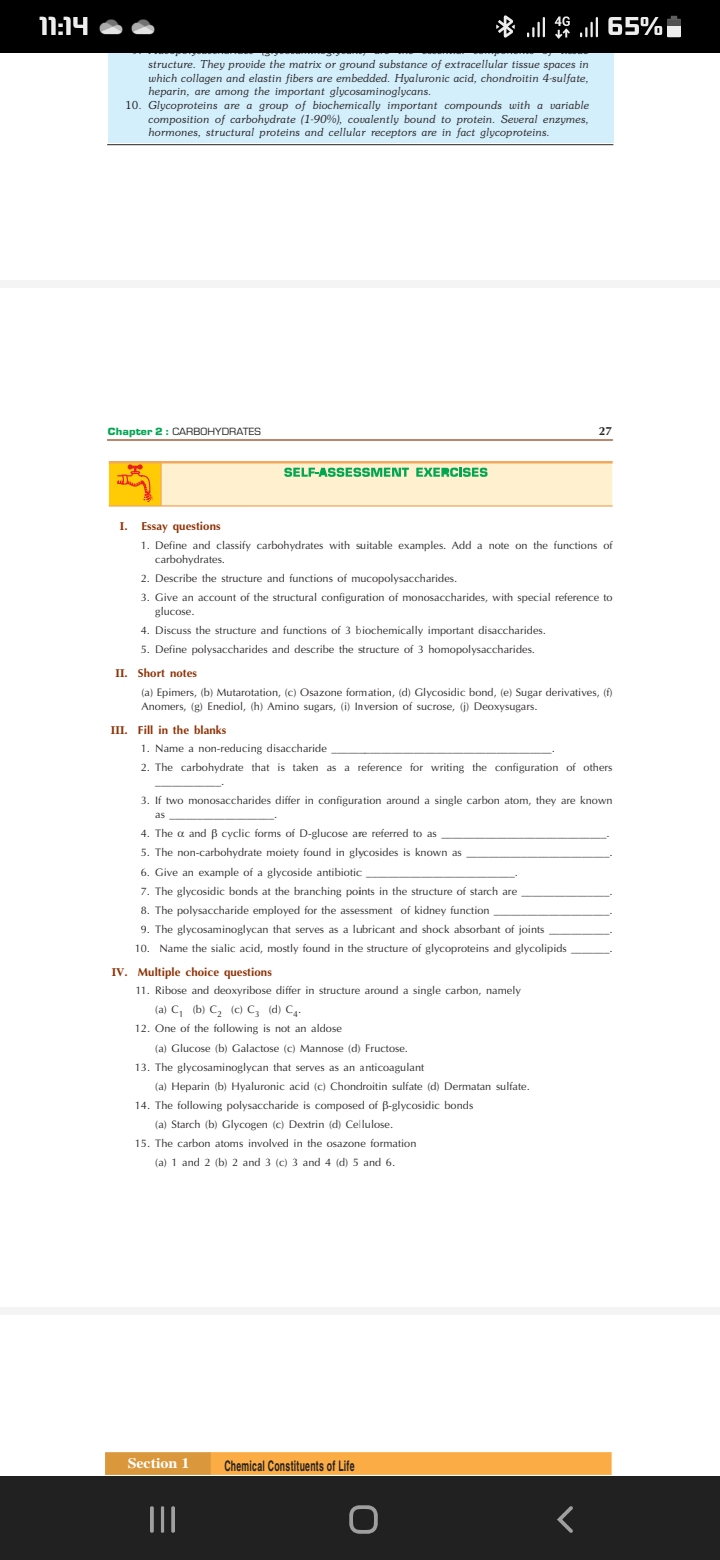I. Essay questions 1. Define and classify carbohydrates with suitable examples. Add a note on the functions of carbohydrates. 2. Describe the structure and functions of mucopolysaccharides. 3. Give an account of the structural configuration of monosaccharides, with special reference to glucose. 4. Discuss the structure and functions of 3 biochemically important disaccharides. 5. Define polysaccharides and describe the structure of 3 homopolysaccharides.
I. Essay questions 1. Define and classify carbohydrates with suitable examples. Add a note on the functions of carbohydrates. 2. Describe the structure and functions of mucopolysaccharides. 3. Give an account of the structural configuration of monosaccharides, with special reference to glucose. 4. Discuss the structure and functions of 3 biochemically important disaccharides. 5. Define polysaccharides and describe the structure of 3 homopolysaccharides.
Biology 2e
2nd Edition
ISBN:9781947172517
Author:Matthew Douglas, Jung Choi, Mary Ann Clark
Publisher:Matthew Douglas, Jung Choi, Mary Ann Clark
Chapter3: Biological Macromolecules
Section: Chapter Questions
Problem 14RQ: Cholesterol is an integral part of plasma membranes. Based on its structure, where is it found in...
Related questions
Question

Transcribed Image Text:11:14
structure. They provide the matrix or ground substance of extracellular tissue spaces in
which collagen and elastin fibers are embedded. Hyaluronic acid, chondroitin 4-sulfate,
heparin, are among the important glycosaminoglycans.
10. Glycoproteins are a group of biochemically important compounds with a variable
composition of carbohydrate (1-90%), covalently bound to protein. Several enzymes,
hormones, structural proteins and cellular receptors are in fact glycoproteins.
Chapter 2: CARBOHYDRATES
SELF-ASSESSMENT EXERCISES
I. Essay questions
1. Define and classify carbohydrates with suitable examples. Add a note on the functions of
carbohydrates.
2. Describe the structure and functions of mucopolysaccharides.
3. Give an account of the structural configuration of monosaccharides, with special reference to
glucose.
4. Discuss the structure and functions of 3 biochemically important disaccharides.
5. Define polysaccharides and describe the structure of 3 homopolysaccharides.
III. Fill in the blanks
II. Short notes
(a) Epimers, (b) Mutarotation, (c) Osazone formation, (d) Glycosidic bond, (e) Sugar derivatives, (f)
Anomers, (g) Enediol, (h) Amino sugars, (i) Inversion of sucrose, (j) Deoxysugars.
* | 4 | 65% -
1. Name a non-reducing disaccharide
2. The carbohydrate that is taken as a reference for writing the configuration of others
4. The a and B cyclic forms of D-glucose are referred to as
5. The non-carbohydrate moiety found in glycosides is known as
3. If two monosaccharides differ in configuration around a single carbon atom, they are known
as
6. Give an example of a glycoside antibiotic
7. The glycosidic bonds at the branching points in the structure of starch are
8. The polysaccharide employed for the assessment of kidney function
9. The glycosaminoglycan that serves as a lubricant and shock absorbant of joints
10. Name the sialic acid, mostly found in the structure of glycoproteins and glycolipids
IV. Multiple choice questions
11. Ribose and deoxyribose differ in structure around a single carbon, namely
(a) C₁ (b) C₂ (c) C₂ (d) C₁.
12. One of the following is not an aldose
(a) Glucose (b) Galactose (c) Mannose (d) Fructose.
13. The glycosaminoglycan that serves as an anticoagulant
(a) Heparin (b) Hyaluronic acid (c) Chondroitin sulfate (d) Dermatan sulfate.
14. The following polysaccharide is composed of B-glycosidic bonds
(a) Starch (b) Glycogen (c) Dextrin (d) Cellulose.
15. The carbon atoms involved in the osazone formation
(a) 1 and 2 (b) 2 and 3 (c) 3 and 4 (d) 5 and 6.
Section 1
27
|||
Chemical Constituents of Life
O
Expert Solution
This question has been solved!
Explore an expertly crafted, step-by-step solution for a thorough understanding of key concepts.
This is a popular solution!
Trending now
This is a popular solution!
Step by step
Solved in 5 steps with 1 images

Recommended textbooks for you

Biology 2e
Biology
ISBN:
9781947172517
Author:
Matthew Douglas, Jung Choi, Mary Ann Clark
Publisher:
OpenStax

Biochemistry
Biochemistry
ISBN:
9781305577206
Author:
Reginald H. Garrett, Charles M. Grisham
Publisher:
Cengage Learning

Biology 2e
Biology
ISBN:
9781947172517
Author:
Matthew Douglas, Jung Choi, Mary Ann Clark
Publisher:
OpenStax

Biochemistry
Biochemistry
ISBN:
9781305577206
Author:
Reginald H. Garrett, Charles M. Grisham
Publisher:
Cengage Learning